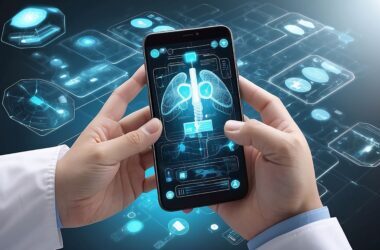Amidst the burgeoning advancements in healthcare technology, one innovation stands out as a potential game-changer – bioprinting. With an estimated 17 people dying each day waiting for an organ transplant, this cutting-edge technology offers a glimmer of hope in addressing the critical organ shortage crisis.
Bioprinting, a pioneering healthcare technology, harnesses the convergence of engineering, biology, and cutting-edge materials science to offer a revolutionary solution. By precisely depositing biomaterials, such as stem cells and hydrogels, layer by intricate layer, this process enables the creation of complicated, living structures that mimic the complexity of human organs. Bioprinted organs promise to overcome the limitations of traditional transplantation by meticulously replicating native tissue architectures and seamlessly integrating vascular networks.
This post highlights the rising importance of bioprinting and the recent developments in this field, which have made things most of us have imagined in fiction possible.
Content Index:
- The Organ Shortage Crisis
- How Does Bioprinting Works For Organs?
- Latest Breakthroughs In Bioprinting
- Challenges & Ethical Considerations
- Advantages Of Bioprinting
The Organ Shortage Crisis
It is found that the demand for organ transplants continues to exceed the supply, with an estimated 103,223 individuals (men, women, and children) currently on the waiting list in the United States alone. Traditional organ donation, while invaluable, faces inherent limitations, including limited availability, compatibility issues, and the risk of rejection. This crisis has far-reaching consequences, impacting the quality of life for countless individuals and straining healthcare resources.
However, bioprinting emerges as a beacon of hope, harnessing the power of biomaterials and precision engineering. This state-of-the-art approach holds the potential to revolutionize organ production, offering personalized, compatible constructs tailored to individual needs. By addressing the critical shortage, bioprinting could alleviate the strain on donor networks and unlock new frontiers in accessible, sustainable organ transplantation.
How Bioprinting Works For Organs?
A subset of 3D printing technology, bioprinting utilizes specialized bio inks and hydrogels to create intricate, living structures layer by layer. These bio inks are derived from biomaterials, such as stem cells, proteins, and other biomolecules, carefully engineered to mimic the properties of natural tissues. The printing process involves depositing these bio inks in precise patterns, enabling the creation of complex organ structures with remarkable accuracy.
Simply put, a 3D printing process harnesses the patient’s cells to grow organs. This approach can potentially curb the waiting list, substantially lower the chances of organ rejection, and likely eliminate the requirement to take harmful, life-long immunosuppressive medication.
Typically, the process initiates by generating the cells that need to be bioprinted. In the next step, these cells are instructed to evolve into organ-specific cell types. These cells are then rendered into a printable organic ink (also known as bio ink); in this step, they are mixed with materials like gelatin or alginate to give them a thick consistency.
Recent Advancements And Breakthroughs
Bioprinting is not new; in fact, the first 3D-printed organ was transplanted into a human bladder in 1999 at Wake Forest Institute for Regenerative Medicine. Most recently, a woman received the world’s first 3D-printed ear implant. Also, media reports for mobile bioprinters that can print skin directly into a wound from a patient’s bedside.
The field of bioprinting has witnessed significant progress in recent years. Research initiatives around the globe have yielded promising results, including the successful printing and transplantation of functional organ constructs in animal models. Organs such as skin, cartilage, and even simpler versions of kidneys and livers have been successfully bioprinted, paving the way for more complex organ structures in the future.
Challenges And Ethical Considerations
While the potential of bioprinting is undeniable, it is not without its challenges. Regulatory hurdles, concerns regarding safety and efficacy, and ethical considerations surrounding the use of biomaterials and stem cells must be carefully navigated. Additionally, the long-term viability and functionality of bioprinted organs remain a subject of ongoing research and evaluation.
Furthermore, the ethical implications surrounding the sourcing and utilization of biomaterials, such as stem cells and biological scaffolds, demand careful deliberation. Issues of consent, ownership, and the potential for exploitation must be addressed through comprehensive guidelines and robust oversight mechanisms. Additionally, the equitable distribution of bioprinted organs and the prevention of undue commercialization pose significant challenges that require ethical governance.
As bioprinting continues to push the boundaries of regenerative medicine, open dialogue and collaborative efforts among researchers, healthcare professionals, policymakers, and bioethicists are crucial. By proactively addressing these challenges and establishing a robust ethical framework, the transformative potential of bioprinting can be harnessed responsibly, paving the way for a future where life-saving organ transplantation becomes more accessible and sustainable.
Advantages Of Bioprinting
Bioprinting offers numerous advantages over traditional organ transplantation methods. Personalized and patient-specific organs can be created, reducing the risk of rejection and increasing compatibility. Furthermore, bioprinted organs have the potential to alleviate the strain on organ donor networks and minimize the need for immunosuppressive drugs post-transplantation.
Moving Forward
As healthcare innovations continue to push boundaries, bioprinting stands at the forefront of revolutionizing organ transplantation. With its potential to address the organ shortage crisis and improve patient outcomes, this technology holds tremendous promise for the future of healthcare. While challenges remain, the combined efforts of researchers, healthcare professionals, and regulatory bodies will pave the way for a future where bioprinted organs become a lifesaving reality.














